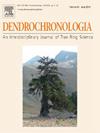研究三种亚地中海树种的干旱后恢复情况:一些树木不受影响,而一些从未恢复
IF 2.7
3区 农林科学
Q1 FORESTRY
引用次数: 0
摘要
该研究旨在评估和比较三种常见的亚地中海物种:黑松(Pinus nigra Arnold),甘露灰(Fraxinus ornus L.)和短毛栎(Quercus pubescens wildl)的生长适应能力。在斯洛文尼亚和意大利两个国家的八个不同地点采集了200多棵树的样本。我们的主要目标是评估和比较个体物种对干旱的反应多样性。从每个站点的树木中提取增量核,然后对其进行处理并测量其树轮宽度。在随后的1983年、1985年、1992年、2000年和2003年,利用夏热水分指数确定了潜在干旱。采用干旱后恢复期和平均相对生长量两个指标分析径向生长弹性。还研究了气候与增长的关系。个别干旱影响了大多数被研究的树木。在这三种被调查的物种中,F. ornus似乎对干旱压力最不敏感。在不同的地点、物种或个体干旱中,有一小部分树木始终不受干旱的影响。部分受影响树木的径向生长在研究期间未恢复,表明个别干旱事件后恢复期超过20年。两者的比例因物种、地点和干旱而异。这些事实表明,未来应该更加重视对“赢家”树的研究,因为它们可能掌握物种对更热干旱的更好适应性的答案。本文章由计算机程序翻译,如有差异,请以英文原文为准。
Examining post-drought recovery in three sub-Mediterranean species: Some trees not affected while some never recover
The study aimed to evaluate and compare growth resilience to hotter droughts of three common sub-Mediterranean species: black pine (Pinus nigra Arnold), manna ash (Fraxinus ornus L.) and pubescent oak (Quercus pubescens Willd). Over 200 trees were sampled across eight different sites in two countries, Slovenia and Italy. Our primary objective was to evaluate and compare diversity in response to drought within individual species. Increment cores were extracted from trees from each site, which were then processed and their tree-ring width measured. Potential droughts were identified using a Summer-Heat moisture index in the following years 1983, 1985, 1992, 2000 and 2003. Radial growth resilience was analyzed using two indices, post-drought recovery period and average relative growth reduction. Climate-growth relationships were also examined. The individual droughts affected the majority of studied trees. Of the three examined species, F. ornus appears to be the least sensitive to drought stress. Across sites, species or individual droughts, a small proportion of trees always remained unaffected by the droughts. Some of the affected trees never recovered their radial growth within the studied period, indicating that their recovery period exceeded 20 years after individual drought events. The proportion of both varied between species, site and drought. These facts would indicate that more emphasis should be given in the future to studying “winner” trees, since they may hold the answer to species’ better adaptability to the occurrence of hotter droughts.
求助全文
通过发布文献求助,成功后即可免费获取论文全文。
去求助
来源期刊

Dendrochronologia
FORESTRY-GEOGRAPHY, PHYSICAL
CiteScore
5.50
自引率
13.30%
发文量
82
审稿时长
22.8 weeks
期刊介绍:
Dendrochronologia is a peer-reviewed international scholarly journal that presents high-quality research related to growth rings of woody plants, i.e., trees and shrubs, and the application of tree-ring studies.
The areas covered by the journal include, but are not limited to:
Archaeology
Botany
Climatology
Ecology
Forestry
Geology
Hydrology
Original research articles, reviews, communications, technical notes and personal notes are considered for publication.
 求助内容:
求助内容: 应助结果提醒方式:
应助结果提醒方式:


